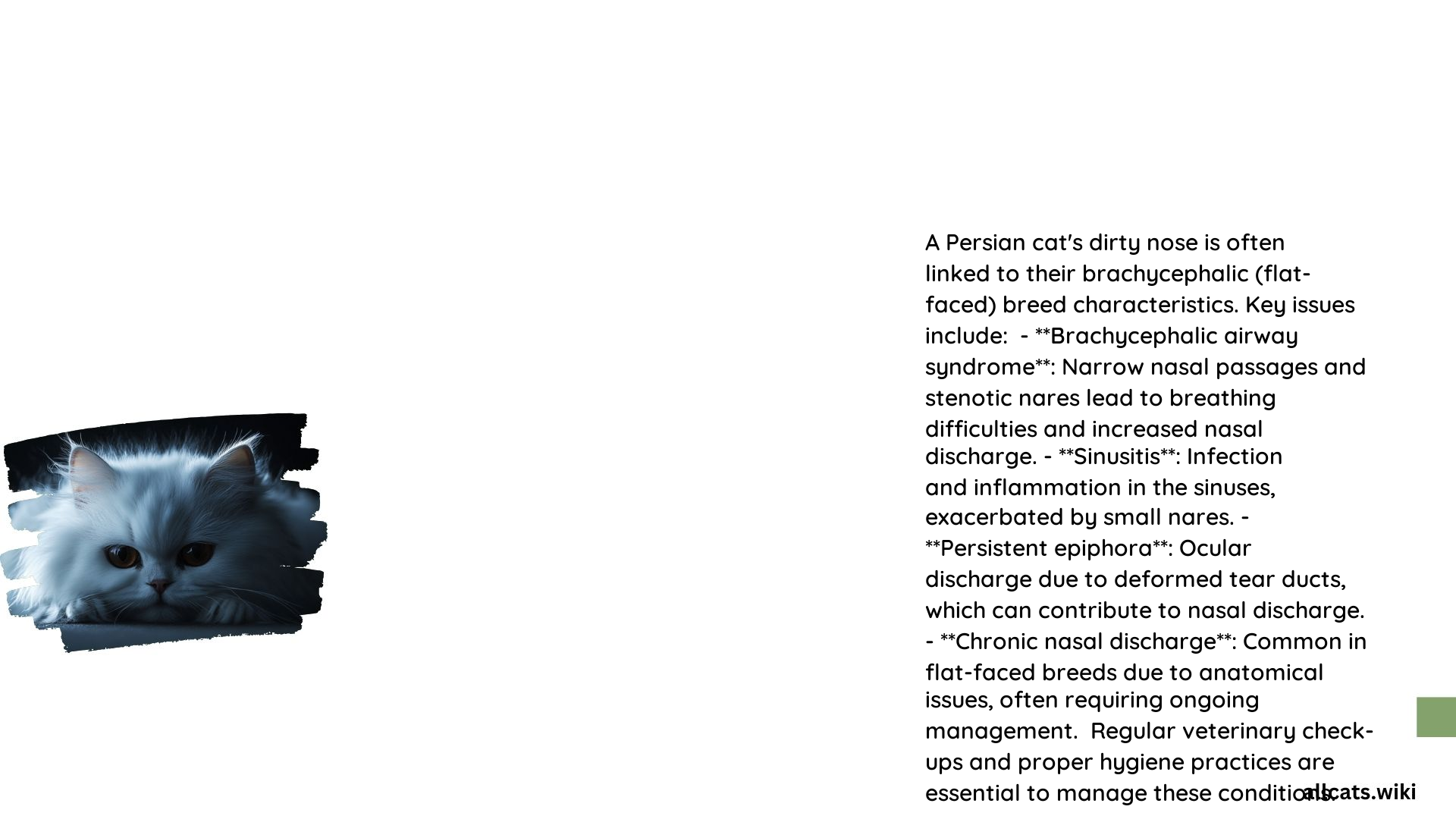Comprehensive Guide for Persian Cat Owners: Managing a Dirty Nose
Persian cats are known for their distinctive flat faces and long, luxurious coats, but their unique features can also lead to some common health issues, including a persistent dirty nose. This comprehensive guide will address the common causes, effective cleaning methods, and practical considerations for managing a Persian cat’s dirty nose.
What Causes a Dirty Nose in Persian Cats?
The primary reasons for a dirty nose in Persian cats are related to their brachycephalic (flat-faced) head morphology, which can lead to several health problems:
-
Brachycephalic Head Morphology: The short, flat nose of Persian cats results in stenotic nares (narrow nostrils) and narrow nasal passages, which can cause breathing difficulties and contribute to nasal discharge and sinusitis.
-
Sinusitis: Inflammation and infection in the sinuses can lead to a runny nose. The narrow nasal passages and small nares in Persian cats can exacerbate sinusitis.
-
Eye and Tear Duct Issues: Persistent epiphora (ocular discharge) is common in Persian cats due to the malformation of their tear ducts, which can lead to tear stains and skin infections around the nose.
-
Dental and Respiratory Issues: Dental disease and brachycephalic airway syndrome can also contribute to overall health issues that may manifest as a dirty nose.
How to Effectively Clean a Persian Cat’s Nose?
Cleaning a Persian cat’s nose requires a gentle and careful approach to avoid discomfort and potential injury. Here’s a step-by-step guide:
-
Prepare the Area: Ensure the area around the cat is quiet and free from distractions.
-
Use Warm Water: Dampen a cotton ball or soft cloth with warm water. Avoid using cold water, which can be uncomfortable.
-
Gently Clean: Gently wipe the nose and surrounding area, being careful not to push too hard, which could cause discomfort or injury.
-
Remove Stains: For tear stains, use a damp cloth to wipe away the stains, working from the outer edge towards the nose to avoid spreading the stain.
-
Dry the Area: Use a dry cloth to gently pat the area dry.
It’s recommended to clean the nose daily to prevent tear stains and reduce the risk of skin infections, but be cautious not to over-clean, as this can irritate the skin.
What Materials and Products Should I Use?
When cleaning a Persian cat’s nose, it’s essential to use the right materials to ensure safety and comfort:
- Warm Water: Sufficient for most cleaning needs. Avoid using harsh chemicals or soaps, which can irritate the skin.
- Cotton Balls or Soft Cloths: These are gentle on the skin and effective for cleaning.
- Specific Cleaning Solutions: If recommended by a veterinarian, use a mild, specifically designed cleaning solution for cats. However, always consult with a veterinarian before using any new products.
Precautions: Avoid touching the cat’s eyes or pushing too hard on the nose, as this can cause discomfort or injury.
When Should I Clean My Persian Cat’s Nose?
Timing and frequency of cleaning are crucial, and there are signs that may indicate a need for more frequent cleaning or a veterinary consultation:
-
Timing: Clean the nose when the cat is most relaxed, such as after a meal or a play session.
-
Frequency: Daily cleaning is recommended, but adjust based on the cat’s individual needs and health status.
-
Signs for Veterinary Consultation:
- Excessive discharge or staining
- Redness or swelling around the nose
- Changes in breathing patterns
- Increased sneezing or nasal discharge
- Any signs of discomfort or pain
How Can I Keep My Persian Cat Calm During Cleaning?
Keeping the cat calm and cooperative during the cleaning process is essential. Here are some tips:
-
Gradual Introduction: Start by gently touching the cat’s nose with a damp cloth while giving treats to associate the process with positive reinforcement.
-
Calm Environment: Ensure the environment is quiet and free from distractions.
-
Handling Resistance: If the cat shows resistance, stop immediately and try again later. Gradually increase the duration and frequency of cleaning sessions.
-
Positive Reinforcement: Reward the cat with treats and praise for remaining calm during the cleaning process.
By following these guidelines, you can effectively manage a Persian cat’s dirty nose and maintain their overall health and well-being.
References:
1. JustAnswer: “Hi, I have a Persian cat and he constantly has a runny nose, with a lot of…”
2. UFAW: “Persian – Brachycephaly – UFAW”
3. Wag: “Nose Skin Disease in Cats – Symptoms, Causes, Diagnosis…”

